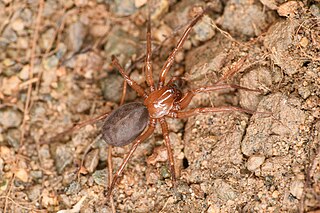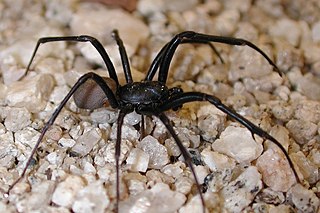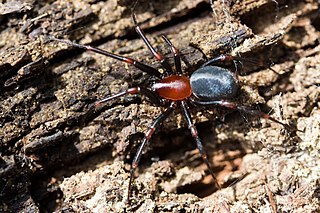
The Agelenidae are a large family of spiders in the suborder Araneomorphae. Well-known examples include the common "grass spiders" of the genus Agelenopsis. Nearly all Agelenidae are harmless to humans, but the bite of the hobo spider may be medically significant, and some evidence suggests it might cause necrotic lesions, but the matter remains subject to debate. The most widely accepted common name for members of the family is funnel weaver.

Linyphiidae, spiders commonly known as sheet weavers, or money spiders is a family of very small spiders comprising 4706 described species in 620 genera worldwide. This makes Linyphiidae the second largest family of spiders after the Salticidae. The family is poorly understood due to their small body size and wide distribution; new genera and species are still being discovered throughout the world. The newest such genus is Himalafurca from Nepal, formally described in April 2021 by Tanasevitch. Since it is so difficult to identify such tiny spiders, there are regular changes in taxonomy as species are combined or divided.

Cybaeidae is a family of spiders first described by Nathan Banks in 1892. The diving bell spider or water spider Argyroneta aquatica was previously included in this family, but is now in the family Dictynidae.

Ralph Vary Chamberlin was an American biologist, ethnographer, and historian from Salt Lake City, Utah. He was a faculty member of the University of Utah for over 25 years, where he helped establish the School of Medicine and served as its first dean, and later became head of the zoology department. He also taught at Brigham Young University and the University of Pennsylvania, and worked for over a decade at the Museum of Comparative Zoology at Harvard University, where he described species from around the world.

Philoponella is a genus of uloborid spiders. Like all Uloboridae, these species have no venom.

Homalonychus is a genus of araneomorph spiders, and is the only genus in the family Homalonychidae. It was first described by George Marx in 1891. As of October 2023 it contains only two species: H. selenopoides and H. theologus. They are found in the southern United States and Mexico: H. theologus is mostly found west of the Colorado River, while H. selenopoides is mostly found to the east, with some populations in Death Valley and near Mercury, Nevada.
Saltonia is a monotypic genus of North American cribellate araneomorph spiders in the family Dictynidae containing the single species, Saltonia incerta. It was first described by R. V. Chamberlin & Wilton Ivie in 1942, and has only been found in United States. Originally placed with the funnel weavers, it was moved to the Dictynidae in 1967.

Plectreuridae, also called plectreurid spiders, is a small spider family confined to the Southwestern United States, Mexico, and the Caribbean. Only two living genera are known—the nominate genus Plectreurys and Kibramoa. In the past, the family was more widespread, with the Jurassic genus Eoplectreurys known from China, the Eocene Palaeoplectreurys baltica from Baltic amber and the Miocene Plectreurys pittfieldi from Dominican amber.

Caponiidae is a family of ecribellate haplogyne spiders that are unusual in a number of ways. They differ from other spiders in lacking book lungs and having the posterior median spinnerets anteriorly displaced to form a transverse row with the anterior lateral spinnerets. Most species have only two eyes, which is also unusual among spiders. A few species of Caponiidae variously have four, six or eight eyes. In some species the number of eyes will increase when the spiderling changes its skin as it grows towards adulthood.

Kibramoa is a genus of North American plectreurid spiders that was first described by Ralph Vary Chamberlin in 1924.

Phrurolithidae is a family of araneomorph spiders, known as guardstone spiders. The family was first described by Nathan Banks in 1892. First included in the Corinnidae as the subfamily Phrurolithinae, later phylogenetic studies justified a separate family.
Nopsides is a monotypic genus of North American araneomorph spiders in the family Caponiidae, containing the single species, Nopsides ceralbonus. It is one of three nopine species, in addition to Tarsonops and Orthonops, described by Ralph Vary Chamberlin from specimens collected from the Baja California region and nearby islands in 1924. They are active during the night, hiding under large stones of Mexico's deserts and xeric shrublands during the day.
Orthonops is a genus of North American araneomorph spiders in the family Caponiidae, first described by R. V. Chamberlin in 1924.
Yorima is a genus of araneomorph spiders in the family Cybaeidae and was first described by R. V. Chamberlin & Wilton Ivie in 1942. Originally placed in the funnel weaver family, it was moved to the Dictynidae in 1967, and to the Cybaeidae in 2017.
Scopoides is a genus of ground spiders that was first described by Norman I. Platnick in 1989.
Anacornia is a genus of North American dwarf spiders that was first described by Ralph Vary Chamberlin & Vaine Wilton Ivie in 1933. As of May 2019 it contains only two species, both found in the United States: A. microps and A. proceps.
Graphomoa is a monotypic genus of North American dwarf spiders containing the single species, Graphomoa theridioides. It was first described by Ralph Vary Chamberlin in 1924, and has only been found in Alabama, Florida, Georgia, Louisiana, and Tennessee.

Helophora is a genus of dwarf spiders that was first described by Anton Menge in 1866.
Idionella is a genus of North American dwarf spiders that was first described by Nathan Banks in 1893.
Phruronellus is a genus of North American araneomorph spiders first described by R. V. Chamberlin in 1921. Originally placed with the Liocranidae, it was moved to the Corinnidae in 2002, and to the Phrurolithidae in 2014.










